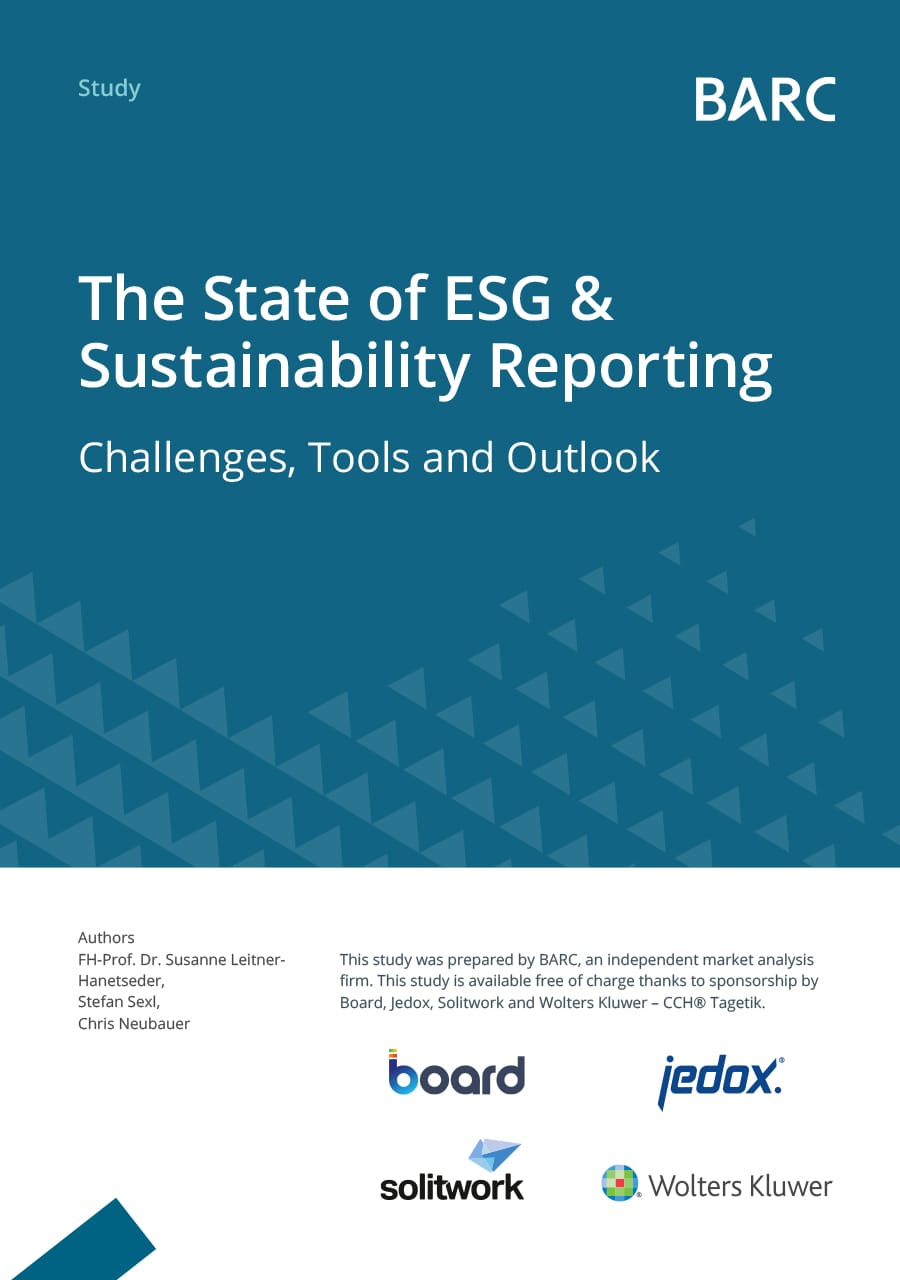
Creating a sustainable future with ESG and finance

Jochen Heßler, Senior Director, Product Management, Jedox
Environmental, social, and governance (ESG) has emerged as an important initiative for organizations worldwide as they strive to implement sustainable practices, achieve compliance, and demonstrate substantive value to customers, employees, and investors. According to KPMG, 65% of international dealmakers believe ESG is a key consideration when making investments and in merger and acquisition decisions,1 and EY reports that 99% of investors use ESG disclosures as a part of their investment decision-making.2 With regulations continually evolving, data volumes expanding, and the need for transparency growing, finance leaders are in a strong position to drive these efforts and create strategic value for their organizations.
Looking to the future, proper ESG data gathering, processing, and analysis will yield benefits such as greater brand loyalty, the ability to secure capital, and increased profits and valuations. Conversely, late adoption and omissions will pose challenges such as a reduction in market share, blacklisting, and severe penalties.1 These pros and cons are enough to motivate the C-suite to expedite their ESG efforts, starting with determining the department responsible for ESG planning and reporting.
Emerging ESG standards and frameworks
Organizations operate in an increasingly complex regulatory environment. In 2022, requirements related to several ESG issues accelerated with the European Financial Reporting Advisory Group (EFRAG) approving the European Sustainability Reporting Standards (ESRS). The standards are designed to bring sustainability reporting on par with financial reporting over time. The ESRS aim to provide a panel of stakeholders with reliable information about an organization’s sustainability-related impacts, risks, and opportunities. According to the concept of double materiality, organizations must report both on how sustainability issues impact their business (outside in) and on how their business activities impact society and the environment (inside out).
The European Commission formally adopted the ESRS on July 31, 2023. Due to the tight adoption timeline, with the first organizations having to report starting January 2024, organizations must pursue new systems, data-gathering processes, and controls necessary to comply with new reporting requirements.
Disclosure requirements will cover four reporting areas: governance, strategy, impact-risk-opportunity management, and metrics and targets. All areas require significant investment in identifying, monitoring, managing, and measuring factors related to an organization.3 Finance professionals recognize the importance of this information, as it often intersects with their core duties and responsibilities.
Additionally, the Global Reporting Initiative (GRI) will provide guidance for GRI reporters on how to use its reporting practices to also meet ESRS requirements. According to the EFRAG, the ESRS are fully aligned with GRI where possible. In cases where full alignment is not feasible due to Corporate Sustainability Reporting Directive (CSRD) mandates, the ESRS strive to maintain the closest possible alignment with GRI.4
Other sustainability reporting initiatives in development include those of the International Sustainability Standards Board (ISSB), developed by the International Financial Reporting Standards (IFRS) Foundation. The U.S. Securities and Exchange Commission (SEC) also proposed rule changes in 2022 that require climate-related disclosures in registration statements and periodic reports, including information about climate-related risks that will likely have a material impact on business and certain climate-related financial statement metrics in a note to their audited financial statements.
The evolving role of finance in ESG
Do finance professionals have the inherent skill set needed to effectively transform ESG initiatives from aspiration to accountability? Their natural aptitude for evaluating the financial impact of various activities and analytical perspective position them well for the task. This is particularly evident when considering how ESG key performance indicators (KPIs) are closely related to aspects in a profit and loss (P&L) statement and significantly impact financial outcomes. For example, incorporating renewable energy sources can influence an organization’s energy costs, affecting P&L figures.
Numerous associations, consultants, and analysts have promoted the idea of the finance function assuming the core responsibility for ESG planning, tracking, and reporting. As early as March 2022, compelling arguments emerged for aligning ESG and financial planning and reporting within the office of finance.5 This consensus has gained further momentum, with Ventana Research reporting that the financial planning and analysis (FP&A) organization is likely to be best positioned to manage ESG planning, analysis, and review processes.6
Forward-looking finance teams already use transformative digital technologies, such as integrated business planning (IBP) solutions, to gather and harmonize data, run analyses and produce reports, and guide decision-making. To leverage these technology investments, finance teams have also honed their organizational networks by partnering with diverse and often faraway global business units. These units may have their own ESG responsibilities and, possessing a comfort level engendered by their existing relationships with FP&A, are willing to work together toward this common goal.
Finally, the variety of plans, environments, and expenditures that make up ESG commitments can change quickly and drastically at times, so a professional discipline with deep experience in scenario planning – a key strength of FP&A – inspires confidence and drives successful outcomes. The planning and informed guidance that goes into creating, recommending, and reporting on an organization’s plans is where FP&A shines and creates value that far exceeds the function’s headcount.
Integrating ESG with FP&A
Looking more closely at the imperatives that make up an ESG framework, they are financial domains and can be characterized as such. Environmental finances include the cost of green sources (think energy consumption), purchase of carbon offsets to achieve a net-zero footprint, and avoiding fees and penalties for compliance violations. Social finances may be more subjective but are no less real than environmental ones, including a reduction in employee churn due to higher satisfaction, increased revenues and customer loyalty, and attracting investment through the demonstration of good corporate citizenship with ESG activities. Governance finances include access to capital prompted by ethical business practices, resulting in increased stakeholder confidence through transparent reporting and possibly an increased valuation. Data lies at the heart of ESG finances, and to achieve one’s ESG goals, this data needs to be integrated with FP&A processes – a task made easier when the latter is already using a planning and performance management platform.
Creating strategic value with ESG planning
ESG planning and reporting can be a disruptive, data-intensive process. According to BARC, the two biggest challenges that organizations face are a lack of data quality and reliability, and too many different data sources.7 Additionally, by 2030, there will be an exponential increase in the amount of ESG data to manage and analyze globally, coming from multiple sources, KPMG predicts.1
Acknowledging that ESG planning is essential and best performed by finance is the first step. It’s then up to finance to incorporate ESG data along with the data from other departments, intertwining them to create a single source of truth. Using a centralized platform combines plans and makes them available to all teams responsible for ESG and other functional groups. This tool can then maximize visibility into all operations, showing the intersection of multiple KPIs with shared dashboards. A unified, strategic plan is created, able to weather changing circumstances, by having ESG data as well as traditional financial data to inform the plan. By integrating ESG indicators alongside financial data using a secure, auditable database solution, finance teams can provide a comprehensive view of the organization’s sustainability performance, allowing stakeholders to assess the environmental and social impact of financial decisions.
For example, Shelf Drilling is committed to reducing greenhouse gas emissions in alignment with the Paris Agreement and implemented Jedox to help achieve its ESG targets. One goal is to reduce daily Scope 1 emissions per rig by 20% by 2026. Although Shelf Drilling’s ability to significantly reduce fuel consumption is constrained by the customer well program, adopting the IBP solution in 2022 played a vital role in supporting those reduction efforts.
Jedox enables all rigs to contribute to planning models through an offline, batched operation. The adaptability that Jedox offers in this regard is of great importance for its usability on the offshore drilling rigs. The cloud-based solution enables near real-time monitoring and synchronization of engine readings and fuel consumption data across the fleet, serving as a single source of truth for greenhouse gas emissions tracking.
Before Jedox, this data was manually captured using Excel, which took a substantial amount of time to consolidate each month. Jedox has replaced manual processes, reduced errors, and provided efficient insights for reducing fuel consumption. Shelf Drilling can now optimize engine hours and advance its sustainability objectives with accurate, timely data. In 2022, Shelf Drilling successfully attained a 5.5% reduction.
Growth opportunities for finance
By embracing ESG reporting, finance teams have the opportunity to drive positive change and improve sustainability within their organizations. Through using an ESG reporting software for integration, data analysis, risk assessment, strategic planning, and stakeholder engagement, finance teams can play a pivotal role in advancing sustainability initiatives, achieving long-term sustainability goals, and ensuring their organization meets evolving compliance standards.
ESG also opens several growth opportunities from a career standpoint. Because ESG’s financial significance is such a major driver, the opportunity for finance professionals to begin to specialize in ESG as a vertical career path is increasing. Along with knowledge of ESG and FP&A theory and practice, using advanced technology, such as Jedox, increases data literacy, leading to a well-rounded skill set and satisfying career.
Conclusion
ESG will continue to be one of the most discussed topics globally as organizations define their strategy, implement ESG initiatives, and report on progress. As compliance and reporting requirements continue to emerge, organizations must either be proactive in taking responsibility for potential externalities affecting the environment and society or risk a material impact on economic value and shareholder returns. To maintain control over this increasingly complex and interrelated ESG landscape, finance teams can lead the way, effectively quantify the financial benefits associated with sustainable practices, and drive confident decision-making across the organization.
Sources
1 KPMG, Looking ahead: 2023 ESG predictions, 2021
2 EY, How finance professionals are helping to advance ESG reporting, March 2022
3 EY, EU Sustainability Developments, November 2022
4 GRI, GRI and the European Sustainability Reporting Standards (ESRS), December 2022
5 Finance Weekly, Why Finance Teams should care about ESG Reporting, March 2022
6 Ventana Research, FP&A Needs a Data Strategy for Meeting Internal ESG Goals, August 2022
7 BARC, The state of ESG and sustainability reporting, 2023




